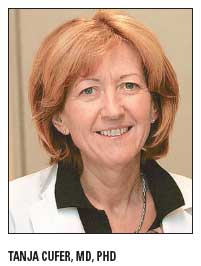Automated planning tools for breast cancer treatment require judicious use
STOCKHOLM-Clinical guidelines and decision-making tools off er evidence based data and prognostic estimates that can help streamline treatment tailoring. But physicians should not rely blindly on these applications as they don’t always off er defi nitive answers, according to a presentation at ESMO 2008.
ABSTRACT: Commonly used decision-making tools in the European Union have advantages, but oncologist know-how is still best for optimizing treatment.
STOCKHOLM-Clinical guidelines and decision-making tools offer evidence based data and prognostic estimates that can help streamline treatment tailoring. But physicians should not rely blindly on these applications as they don’t always offer definitive answers, according to a presentation at ESMO 2008.

Adjuvant!Online and the St. Gallen’s Recommendations/Guidelines are the tools most often used in Europe. Tanja Cufer, MD, PhD, from the Institute of Oncology in Ljubljana, Slovenia, discussed how she believes clinicians can use these tools most effectively in their daily practice.
“Breast cancer is a very heterogeneous disease. With a growing body of new information, it is harder to decide on the best adjuvant therapy for each patient,” Dr. Cufer said.
Two programs, one goal
The St. Gallen’s protocol works with relevant evidence-based data and has been shown to improve patient outcomes. Adjuvant!Online offers prognostic estimates of outcomes to help guide decision-making. The critical questions that both protocols seek to answer are: what is the patient’s risk of relapse and what is the risk of death due to breast cancer? Also, what are the expected relative and absolute benefits of different systemic therapies?
The St. Gallen’s guidelines are updated every 2 years by an international panel that considers expert opinion as well as evidence-based data.
“Though the recommendations tend to be simple, they provide solid and updated knowledge and perspective on using the data intelligently,” Dr. Cufer said (Annals Oncol 18:1133-1144, 2007).

The latest St. Gallen’s guidelines incorporate HER2 status and hormone receptor (HR) status as the primary determinants of treatment allocation. Five patient categories are now recognized: highly endocrine responsive, incompletely endocrine responsive, endocrine nonresponsive, HER2-positive, and HER2-negative. Treatment is assigned accordingly (see Table).
“This seems simplified at first look,” she noted. “But the comprehensive recommendations dissect the Early Breast Cancer Trialists’ Group overview data.”
She added that the guidelines “provide subset analyses of trials that are of paramount importance for optimizing treatment for the individual.”
She pointed out, however, that St. Gallen’s cannot always provide definitive answers when it comes to the oncologist’s chief dilemma, determining which patients will actually benefit from adjuvant chemotherapy.
Adjuvant!Online (available at www.adjuvantonline.com) is a complex and ambitious tool for assessing prognosis and estimating the benefit of a particular therapy. Its validity was confirmed via the British Columbia Cancer Agency database of more than 4,000 patients, which found 10-year predicted and observed outcomes to diff er by only 1%, she noted.
Dr. Cufer said she found these predictions of benefit to be generally reliable but overly optimistic for subgroups with adverse prognostic factors.
Clinicians can partially compensate for this by using the prognostic factor impact calculator (PFIC) within the Adjuvant!Online instrument. The predictions may also be too rosy for younger patients and for combination therapies, she added. “
The major drawback of Adjuvant!Online comes from its simplified and averaged model,” she said. “Today, data from the field of molecular biology shows that prognosis can differ substantially among subsets defined by molecular profiling.”
The Genomic version 7.0 of the Adjuvant!Online gives risk estimates and proportional benefits of hormonal therapy and chemotherapy in ER-positive, node-negative patients according to the OncotypeDX Recurrence Score. But that information is useful only for patients with access to the latter test, which is not widespread throughout Europe.
In Adjuvant! version 9.0, HER2 status will be included as a prognostic variable and trastuzumab will be a treatment option.
“In the era of molecular oncology, there are no recipes for the best adjuvant therapy. Skilled, well-trained oncologists with profound knowledge are the best safeguards for optimizing therapy,” Dr. Cufer said.